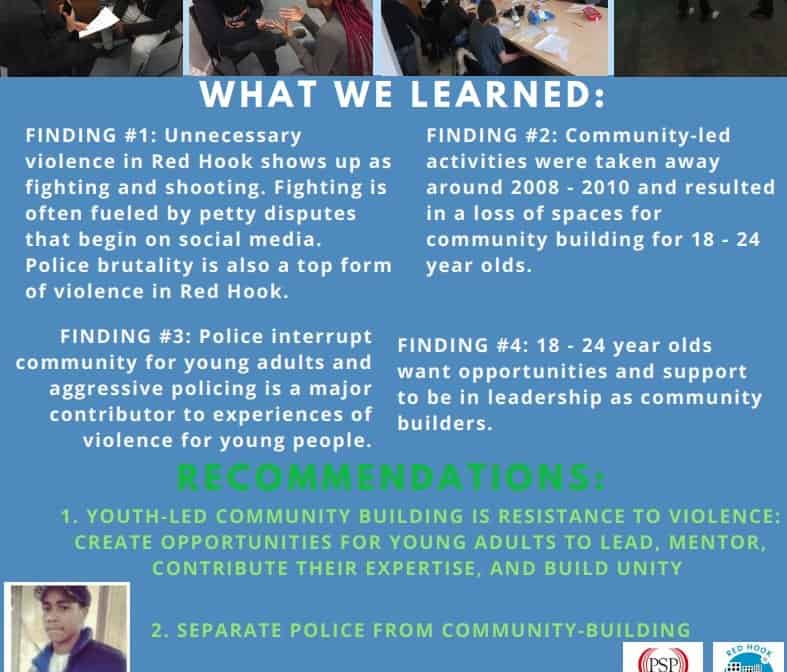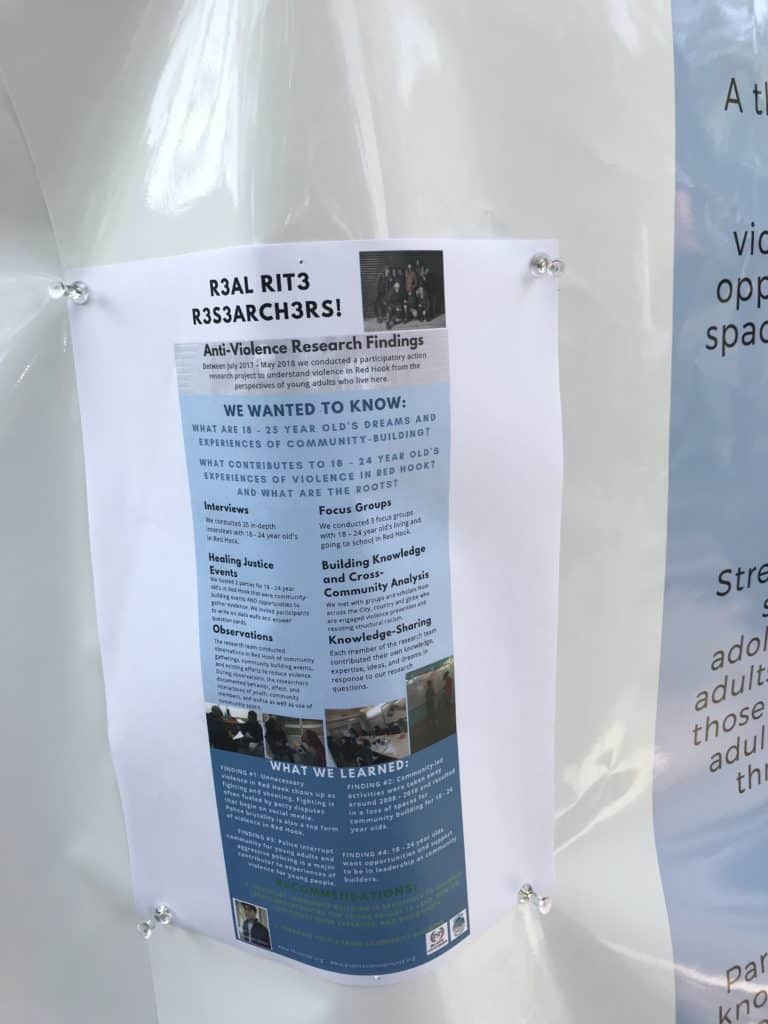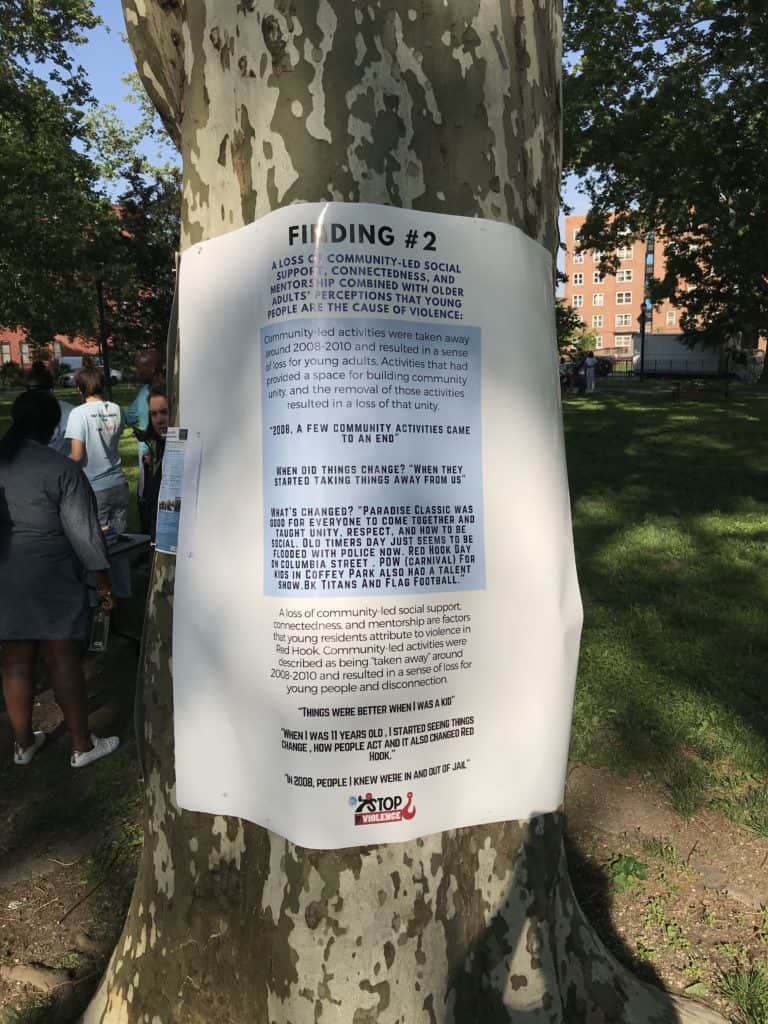
At a time when community policing is taking off throughout the city and Neighborhood Coordination Officers (NCO’s) have been making themselves available throughout the Red Hook Community, the Red Hook Initiative (RHI) has issued a report condemning local police for being a root cause of violence in Red Hook.
RHI’S Real Rite Anti-Violence Research Group, a group that includes Tyneisha Williams, an RHI employee, and Catherine McBride, RHI’s Director of Community Building, traveled to Phoenix last March to speak of their study at the “Innovations in Participatory Democracy Conference.” The groups mission, as stated in the program, is that “We believe participatory democracy is important because if you look at our neighborhood and the way we’re being governed, especially through policing, it’s unjust. We’re the people living with these issues every day so we should have control over the standards and laws governing our community and also hold people in power accountable.”

In a Stop the Violence forum at the Miccio Center last May, featuring Congresswoman Nydia Velazquez, Williams spoke of the study, saying “People say that cops are the main reason for violence in the neighborhood and also not having enough community programming is another result in violence.”
At that event, highlights of their study hung on the wall, including one that proclaimed, “Our findings reveal over policing and police brutality as major contributors to violence for young adults.”
Study findings were on display at an RHI Barbecue/Basketball tournament, held that same week in Coffey Park. Posters describing the report were hung on trees around the barbecue.
The study was conducted between July, 2017 and May, 2018 according to one of the posters. Its goal was to, “understand violence in Red Hook from the perspectives of young adults who live here.”
The report goes on to explain that 35 in-depth interviews were conducted with 18-24-year-old people who either lived or went to school in Red Hook. In addition, parties were held for 18 – 24-year-olds where attendees were invited to answer questions and post thoughts on the walls. In addition, the group observed community gatherings and existing events to reduce violence. They held three focus groups, and worked with “groups and scholars from across the City, country and globe who are engaged [in] violence prevention and resisting structural racism.”
Their conclusions are:
1 – Police brutality as well as disputes that begin on social media are the top forms of violence in Red Hook;
2 – Aggressive policing is a major contributor to experiences of violence for young people;
3 – Community-led activities were taken away around 2008-2010 resulting in a loss of spaces for community building;
4 – 18-24 year-olds want opportunities to become community leaders.
RHI has an annual income of almost $4 million, according to their 2016 IRS filing, and has assets of almost $2.5 million. The bulk of their income comes from institutional supporters, among them AECOM, the company that would like to see a subway and many high rise buildings come to Red Hook; Forest City Ratner Companies, who has built downtown Brooklyn’s Metrotech and Atlantic Yards while fighting grassroots community opposition; and Two Trees, successful gentrifiers of both Dumbo and Williamsburg, and recent purchasers of giant tracts of land in Gowanus, which is about to undergo a massive rezoning, which will transform much of that neighborhood from industrial to luxury residential use.
RHI has been an important supporter of the BQX, the real-estate industry’s trolley car idea supported by Mayor de Blasio, but condemned by many of the communities it would travel through, including Red Hook, Sunset Park and Astoria. Businesses and residents of these waterfront areas fear displacement due to the gentrification that such a trolley would intensify.
The RHI Stop The Violence report states that nearly all the study participants reported seeing or experiencing police brutality. Comments they heard included “Violence in Red Hook? Police Brutality,” and “Police are constantly riding by, intense staring and they shut down my aunts cookout due to noise.” Also, “ The police makes us feel like we don’t belong. I feel the police view the youth of Red Hook as bad and are the cause of a lot of violence that’s going on.”
The report continues: “Yes, police walk up to people for no reason at all and bother them when they have nothing better to do. Standing outside the store even outside the community and they will still get harassed.”
It says “In order to achieve promoting a healthy, safe community for young people, we must separate the police’ role in providing a service to protect the community from young adult’s efforts to heal from trauma and build hope.”
“Our findings of the police impact on the community reveal a violation of young adult’s ability to be free and to have a positive impact on their community through: Harassment, the loss of access to community space, physical violence, and invasive harassment.
On Monday night, June 25, there will be a community meeting, according to a posting on Robert Berrios’ Facebook page. Berrios is a member of the 76th Precinct Community Council, active in Visitation Church, and a longstanding MTA expert.
He writes: “This Coming Monday, June 25 at 7 p.m. at Miccio there will be a Red Hook meeting with the community. There will be no NYCHA, no police or people of authority. There will only be Red Hook residents. Bring your problems, concerns, complaints or ideas. Speak now or forever hold your peace. Nothing and I mean nothing is off limits.”
A series of videos follows. In one of them, longtime resident Henrietta Perkins invites all to come and talk about things, and help “take our community back.”
Nahisha McCoy, who has been a part of RHI, as well as other local non-profits such as Falconworks, Dance Theater Etcetera, Cora Dance, Red Hook Justice Center, and has worked with NYCHA, says on her video that the event is for young adults ages 14-30 who are tired of being bullied and harassed by the police. She calls it a community action meeting, with a goal of finding out ways to change the Red Hook community.













2 Comments
Pingback: Today's Links: A School Custodian Paints Murals in Classrooms, Activists Against Community Policing & More - BKLYNER
We still need community police in Red Hook. It might be a good idea to appoint a monitor to see that things are running smoothly between the police and the residents.I have lived in this community for 65 yrs and I remember when we had community police in theater 60’s and early 70’s. Things went very well then. Officers from back then got to know the residents and their children. They really interacted quite well and were great mentors.